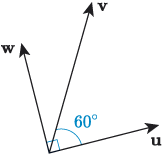4.2 Scalar product of a vector from magnitude and direction
Another way to consider the scalar product is to consider how it is defined in terms of the magnitudes and directions of two vectors. Consider again the vectors and in Figure 29. We want to find out how much vector will grow vector . So again we want to identify how much the vectors interact – and one way to do this is to determine how much vector points in the direction of vector .
In Figure 31, the vectors are arranged so that their tails meet, and this makes it possible to compare their magnitudes and directions. To make this explicit, we can draw the components of , not in terms of horizontal and vertical directions, but in terms of the direction where is pointing, as illustrated in Figure 32(a). Formally, the component of that points in the direction of is called the projection of onto , and if the angle between and is , then the length of the projection of onto is , as shown in Figure 32(b).
Comparing the components of with will give us a measure of how much and interact, as illustrated in Figure 33. In the direction of , has a component of magnitude , and has a component of magnitude , so the contribution to the value of is . Perpendicular to , has a component of magnitude , and has a component of magnitude 0, so the contribution to the value of is 0.
So
and this is a measure of how much the scalar quantity grows the scalar quantity .
and are parallel, so
and the scalar product is given by
Scalar product of vectors in terms of magnitude and direction
The scalar product of two vectors and is
where is the angle between and .

Activity 20
Suppose that , and are vectors with magnitudes 4, 3 and 2 respectively, and directions as shown in the following figure.

Find the following scalar products.
a.
b.
c.



